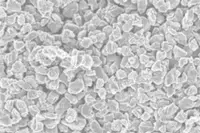 Researchers from North Carolina State University have discovered a new phase of solid carbon, called Q-carbon. It is said to be distinct from known phases of graphite and diamond. They have also developed a technique for using Q-carbon to make diamond-related structures at room temperature and at ambient atmospheric pressure in air.
Researchers from North Carolina State University have discovered a new phase of solid carbon, called Q-carbon. It is said to be distinct from known phases of graphite and diamond. They have also developed a technique for using Q-carbon to make diamond-related structures at room temperature and at ambient atmospheric pressure in air.
Q-carbon - the third solid phase of carbon, alongside diamond and graphite – and is ferromagnetic, which other solid forms of carbon are not. It is also claimed to be harder than diamond and glows when exposed to even low levels of energy.
"Q-carbon's strength and low work-function - its willingness to release electrons - make it very promising for developing new electronic display technologies," said Jay Narayan, the John C. C. Fan Distinguished Chair Professor of Materials Science and Engineering at NC State.
But Q-carbon can also be used to create single-crystal diamond objects. To do this researchers start with a substrate, such as such as sapphire, glass or a plastic polymer. The substrate is then coated with amorphous carbon, an elemental carbon that, unlike graphite or diamond, does not have a regular, well-defined crystalline structure. The carbon is then hit with a single laser pulse lasting approximately 200ns. During this pulse, the temperature of the carbon is raised to around 3727°C and then rapidly cooled. This operation takes place at one atmosphere: the same pressure as the surrounding air.
The end result is a film of Q-carbon. The researchers can control the process to make films between 20 and 500nm thick. By using different substrates and changing the duration of the laser pulse, the researchers can also control how quickly the carbon cools, creating diamond structures within the Q-carbon.
"We can create diamond nanoneedles or microneedles, nanodots, or large-area diamond films, with applications for drug delivery, industrial processes and for creating high-temperature switches and power electronics," Narayan said. "These diamond objects have a single-crystalline structure, making them stronger than polycrystalline materials. And it is all done at room temperature and at ambient atmosphere. So, not only does this allow us to develop new applications, but the process itself is relatively inexpensive."
Narayan continued: "We can make Q-carbon films, and we're learning its properties, but we are still in the early stages of understanding how to manipulate it. We know a lot about diamond, so we can make diamond nanodots. We don't yet know how to make Q-carbon nanodots or microneedles. That's something we're working on."
Author
Tom Austin-Morgan
Source: www.newelectronics.co.uk

